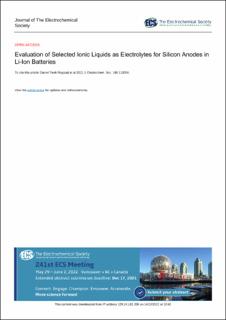| dc.contributor.author | Rogstad, Daniel Tevik | |
| dc.contributor.author | Einarsrud, Mari-Ann | |
| dc.contributor.author | Svensson, Ann Mari | |
| dc.date.accessioned | 2022-01-03T09:19:32Z | |
| dc.date.available | 2022-01-03T09:19:32Z | |
| dc.date.created | 2021-11-14T21:06:56Z | |
| dc.date.issued | 2021 | |
| dc.identifier.issn | 0013-4651 | |
| dc.identifier.uri | https://hdl.handle.net/11250/2835738 | |
| dc.description.abstract | In this work, four selected ionic liquids (ILs), in combination with lithium bis(fluorosulfonyl)imide salt (LiFSI) were explored as electrolytes for anodes made from micron-sized metallurgical grade silicon. The ionic liquids were based on the cations; pyrrolidinium (PYR13), imidazolium (EMI) and phosphonium (P111i4) and the anions; bis(fluorosulfonyl)imide (FSI) and bis(trifluorosulfonyl)imide (TFSI). The cycling stability and rate performance were investigated in pseudo-full cells with silicon anode and commercial LiFePO4, and compared to a carbonate electrolyte. Electrolytes based on PYR13FSI and P111i4FSI exhibit a decent rate performance up to C/5 and showed stable cycling over ∼100 cycles, maintaining a reversible capacity of >1200 mAh gSi-1 at cycle 100 (C/5 rate) and over 2000 mAh gSi-1 at C/20. These electrolytes also had the best oxidation stability (> 5.3 V vs Li/Li). Based on assessment of the limiting current density in symmetrical cells, the Li-ion mobility was determined to be slightly higher for EMIFSI, but differences in Li-ion mobility cannot account for the differences in cycling stability among these electrolytes. While the SEI formed in EMIFSI electrolyte is the most conductive, the highest coulombic efficiency was obtained for PYR13FSI, indicating that the best passivating SEI was formed in this electrolyte. | en_US |
| dc.language.iso | eng | en_US |
| dc.publisher | Electrochemical Society | en_US |
| dc.rights | Navngivelse 4.0 Internasjonal | * |
| dc.rights.uri | http://creativecommons.org/licenses/by/4.0/deed.no | * |
| dc.title | Evaluation of selected ionic liquids as electrolytes for silicon anodes in li-ion batteries | en_US |
| dc.type | Peer reviewed | en_US |
| dc.type | Journal article | en_US |
| dc.description.version | publishedVersion | en_US |
| dc.source.volume | 168 | en_US |
| dc.source.journal | Journal of the Electrochemical Society | en_US |
| dc.source.issue | 11 | en_US |
| dc.identifier.doi | 10.1149/1945-7111/ac330f | |
| dc.identifier.cristin | 1954395 | |
| dc.description.localcode | © 2021 The Author(s). Published on behalf of The Electrochemical Society by IOP Publishing Limited. This is an open access article distributed under the terms of the Creative Commons Attribution 4.0 License (CC BY, http://creativecommons.org/licenses/ by/4.0/), which permits unrestricted reuse of the work in any medium, provided the original work is properly cited. | en_US |
| cristin.ispublished | true | |
| cristin.fulltext | original | |
| cristin.qualitycode | 2 | |

